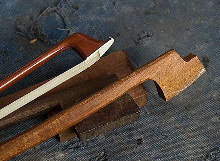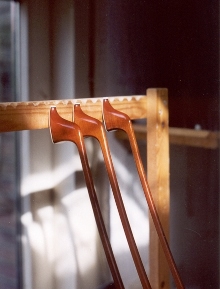 The Frenchman François Tourte (1748–1835) is for bow makers what Stradivarius is for violin makers. He laid down the standard for the modern bow and was the first to use Pernambuco wood, which gives the perfect ratio between weight, balance and flexibility.
The Frenchman François Tourte (1748–1835) is for bow makers what Stradivarius is for violin makers. He laid down the standard for the modern bow and was the first to use Pernambuco wood, which gives the perfect ratio between weight, balance and flexibility.
Other famous bow makers from the past are, among others, Peccatte, Henry, Simon, Lamy en Sartory from France, Dodd, Tubbs and Hill from Engeland and Knopff, Nürnberger and Pfretzschner from Germany. Until the end of the eighties of the 20th century, hardly any specialised bow makers were to be found in the Netherlands. Mostly, bow work was done by violin makers.
 Several materials are being used in a bow. The stick of a modern bow is made of wood or a synthetic material. Baroque bows are made of snake wood. The mounting – the screw, the heel of the frog and the D-ring – are from metal. Depending on the quality and price of the bow, this could be nickel silver, silver or gold. Usually ebony is used for the frog, but in cheaper bows this is sometimes replaced by a synthetic material. The sides of the frog are often decorated by a mother of pearl eye. This same material is often used for the slide on the bottom of the frog. Where the thumb holds the bow, there is a thumb piece, made of (imitation)leather. The winding, next to the thumb piece, is made of silver and silk (sometimes bicolour). The face at the tip of the bow is often made of ivory, bone or silver. The stick is strung with horse hair, from Mongolia or Siberia.
Several materials are being used in a bow. The stick of a modern bow is made of wood or a synthetic material. Baroque bows are made of snake wood. The mounting – the screw, the heel of the frog and the D-ring – are from metal. Depending on the quality and price of the bow, this could be nickel silver, silver or gold. Usually ebony is used for the frog, but in cheaper bows this is sometimes replaced by a synthetic material. The sides of the frog are often decorated by a mother of pearl eye. This same material is often used for the slide on the bottom of the frog. Where the thumb holds the bow, there is a thumb piece, made of (imitation)leather. The winding, next to the thumb piece, is made of silver and silk (sometimes bicolour). The face at the tip of the bow is often made of ivory, bone or silver. The stick is strung with horse hair, from Mongolia or Siberia.
The stick of most modern handmade bows is from Pernambuco wood, a hardwood variety from the province of Pernambuco in Brazil. In the old days, this wood was being imported into Europe for its purple-red pigments, which were used in the textile industry. For obtaining the pigments, the wood needed to be rasped. Because the rasping of this wood caused many allergic reactions, the work was usually done by criminals who were convicted to the so called rasp-house. Nowadays, the wood is only being used for bow making. Cheaper, often industrially made, bows are often made of Brazil wood.
